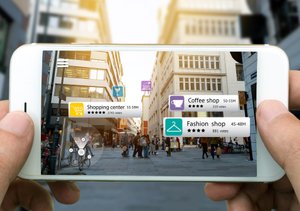Augmented reality is the only thing that can overcome VR in the sphere of marketing.
AR is a powerful tool of visualization that conveys ideas through images in the most interactive and engaging way. It thrills; it excites; it works. Global AR ad revenue in 2018 reached $428 million and is expected to triple by 2021.
Here are four reasons why AR works so well for marketing purposes.
Innovation and interest
People want to be entertained. They yearn for new and exciting things. Marketers are always looking for better ways to attract the attention of the customer. Augmented reality meets these requirements perfectly.
The technology is relatively new. It stands out among posters, commercials and social media ads. AR has a vibe of futurism, novelty and progress that many people find very attractive. Augmented reality intrigues and awakes curiosity. It makes people wonder how it works and speak about it. AR is a great tool that makes advertising campaigns go viral and spread through word of mouth. Who wouldn’t like to experience something everybody is talking about?
On top of that, using AR in marketing campaigns also adds to your brand image. A company that applies innovative solutions is seen itself as innovative and up-to-date. AR solutions distinguish your company from the competitors by creating a positive emotional response and making it memorable for users.
Flexibility
AR technology has nearly endless possibilities and variations. AR ads can take the form or look that meets the goal of the campaign the best. There can be solutions for almost every industry or thing advertised: retail, automotive, education, healthcare, etc. There can be videos or static images, 3D models or flat pictures, informative or entertaining content. Augmented reality advertisements are not limited to any scripts, rules or frames, so customers can always expect something new when they open an AR app on their phone.
For business, such a range of options also means a range of prices. For a smaller budget, one can try AR platforms where they pay for a subscription and create there own AR experience. You can use these app creator platforms knowing nothing about coding and make simple experiences with a couple of clicks.
On the other hand, big projects may require more well-thought and complex solutions. Custom-created applications that go through a whole production cycle from design to testing and support can be pricy, but the result is worth it. The company gets a unique branded application to promote its services. Complex solutions enable interactivity which makes the next point of interest.
Interactivity
Interactivity is an essential element of AR technology. The digital image merges together with the real world on the command of the user. They see how their usual environment is enhanced with virtual elements they can change and play with. It can be a 3D model of a hotel; they can walk around or virtually place furniture in a house. Anything more than just watching increases customer’s engagement dramatically.
Another way to engage the customer is by using geo-location. Using information from a smartphone, an AR app can show consumers where to look for another entertaining experience. Location-based applications can serve as a local expert, a map, a gaming location guide and more.
The element of gamification makes AR experience more valuable and memorable. People are likely to enjoy an AR experience and come back to the app, so the ad and the brand are exposed to them again and again. This repeated engagement makes the cost/efficiency ratio more beneficial than of printed ads or video commercials.
Better customer experience
Nearly 65 percent of users find ads annoying or intrusive, mainly because advertisements disrupt their activity. It leads to the negative perception of the ad piece itself and the brand that is being promoted.
AR ads, which the user can run at will, look much more attractive than pop-up banners that block half the page. The customer feels valued and reacts positively to the brand reference — especially if the ad is personalized to their needs and interests.
Personalized ads is not a new thing in marketing, but custom AR ads can take it to the next level. Interactive AR applications can enable users to download their own media and create custom content. While still promoting a brand or service, the ad will be personal and unique for each customer.
For these reasons and more, AR solutions can make marketing more on-the-spot and more relevant, ultimately improving customer experience and adding new value to customer/brand relationships.
Victor Bogomolov
I am a tech enthusiast and have found VR/AR to be my passion. I am the CEO and co-founder of VR Tigers, an IT company that makes custom solutions for businesses. I have more than 10-year experience in software development and three years in the extended realities field.
Like this article? Sign up for more great content.
Be part of Business.com
Already a member? Sign in.
We’d love to hear your voice! Login to comment.

